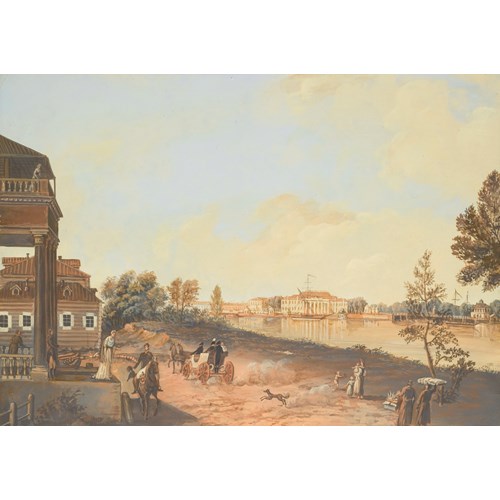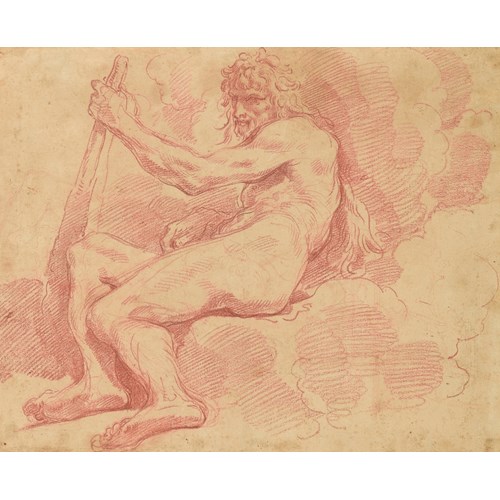Marketplace
Carts Fording a River, Prilepa, Tula Oblast
Georgy Konstantinovich Savitsky
Carts Fording a River, Prilepa, Tula Oblast
Date 1922
Epoque 20th century
Origine Russia
Medium Oil on board
Dimension 39 x 54.8 cm (15³/₈ x 21⁵/₈ inches)
In this work, Georgy Konstantinovich Savitsky has depicted idyllic scene of rural life on a warm summer’s day. Two horse and carts are fording the slither of water that runs right across the foreground. The leading horse has his head bowed, as he strains to pull his heavy load, which is sinking into the soggy bank. Sitting atop the mound of hay is man and his child, who has been allowed to hold the reins. Bounding along on either side is a dog and a boisterous foal. The second cart seems almost to have come to a halt, as the horse is more interested in drinking the water, than dragging his cart through it. Another tributary in the middle-ground is obviously deeper, as a bridge is required to cross it, and on the left-hand side several nude figures can be seen bathing in the cool water. Savitsky uses broad expressive brushstrokes in a warm palette, which progresses in bands, from yellow, to green, to the blue of the sky in the upper third of the canvas. The work is an idealised vision of simple, prosperous life in rural Russia.
Savitsky was an accomplished equine painter and horses feature prominently in most of his paintings, although in a variety of contexts. In Yelatma, (Private Collection) he depicted a gloriously bright rural scene, comparable to Carts Fording a River. The motif of horse and cart is central to both works, as they make their way through the rural landscapes. Both works feature the same loose and fluid brushwork, as well as Savitsky’s technique of using broad bands of colour throughout the landscapes. Although Carts Fording a River is arguably the more sophisticated of the two, Yeltma also demonstrates Savitsky’s ability to capture the specific atmosphere of a scene. Whereas there is a lushness and pleasant warmth to the present work, it feels as if Savitsky has depicted the landscape at the height of summer, when conditions are arid and harsher. These works depict life in rural Russia as appealing and sun-filled, hardworking, but certainly not arduous.
Savitsky was the son of the famous Russian realist painter, Konstantin Apollonovich Savitsky (1844-1905), one of the leading figures in nineteenth-century Russian painting and a member of the influential Peredvizhniki group. Georgy’s initial training was with his father, before he enrolled in the important Penza Art School from 1908 to 1915. He was one of the best pupils in an outstanding generation, and he graduation picture, depicting the death of King Priam, earned him scholarship to travel.
Savitsky’s early career was dominated by his equestrian works, many of which today can be found in the State Equestrian Museum in Moscow. However, he very quickly became a key figure in the new Soviet regime’s cultural drive, initially helping to design the celebrations of revolutionary holidays. He also started to paint battle pictures, depicting revolutionary history and the Soviet way of life. He was a key member of the AKhRR, the leading artistic movement in Russia during the 1920’s, and also worked as an illustrator and poster designer, in the promotion of the Soviet regime. Although he won great acclaim in Russia for his dramatic, large-scale historical paintings, he repeatedly returned to the themes found in Carts Fording a River, of idealised, tranquil rural life, centred around the horse.
Savitsky was an accomplished equine painter and horses feature prominently in most of his paintings, although in a variety of contexts. In Yelatma, (Private Collection) he depicted a gloriously bright rural scene, comparable to Carts Fording a River. The motif of horse and cart is central to both works, as they make their way through the rural landscapes. Both works feature the same loose and fluid brushwork, as well as Savitsky’s technique of using broad bands of colour throughout the landscapes. Although Carts Fording a River is arguably the more sophisticated of the two, Yeltma also demonstrates Savitsky’s ability to capture the specific atmosphere of a scene. Whereas there is a lushness and pleasant warmth to the present work, it feels as if Savitsky has depicted the landscape at the height of summer, when conditions are arid and harsher. These works depict life in rural Russia as appealing and sun-filled, hardworking, but certainly not arduous.
Savitsky was the son of the famous Russian realist painter, Konstantin Apollonovich Savitsky (1844-1905), one of the leading figures in nineteenth-century Russian painting and a member of the influential Peredvizhniki group. Georgy’s initial training was with his father, before he enrolled in the important Penza Art School from 1908 to 1915. He was one of the best pupils in an outstanding generation, and he graduation picture, depicting the death of King Priam, earned him scholarship to travel.
Savitsky’s early career was dominated by his equestrian works, many of which today can be found in the State Equestrian Museum in Moscow. However, he very quickly became a key figure in the new Soviet regime’s cultural drive, initially helping to design the celebrations of revolutionary holidays. He also started to paint battle pictures, depicting revolutionary history and the Soviet way of life. He was a key member of the AKhRR, the leading artistic movement in Russia during the 1920’s, and also worked as an illustrator and poster designer, in the promotion of the Soviet regime. Although he won great acclaim in Russia for his dramatic, large-scale historical paintings, he repeatedly returned to the themes found in Carts Fording a River, of idealised, tranquil rural life, centred around the horse.
Date: 1922
Epoque: 20th century
Origine: Russia
Medium: Oil on board
Signature: Signed in Cyrillic and dated '1922' (lower right) and further inscribed and dated in Cyrillic verso.
Dimension: 39 x 54.8 cm (15³/₈ x 21⁵/₈ inches)
Plus d'œuvres d'art de la Galerie









